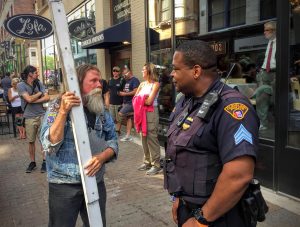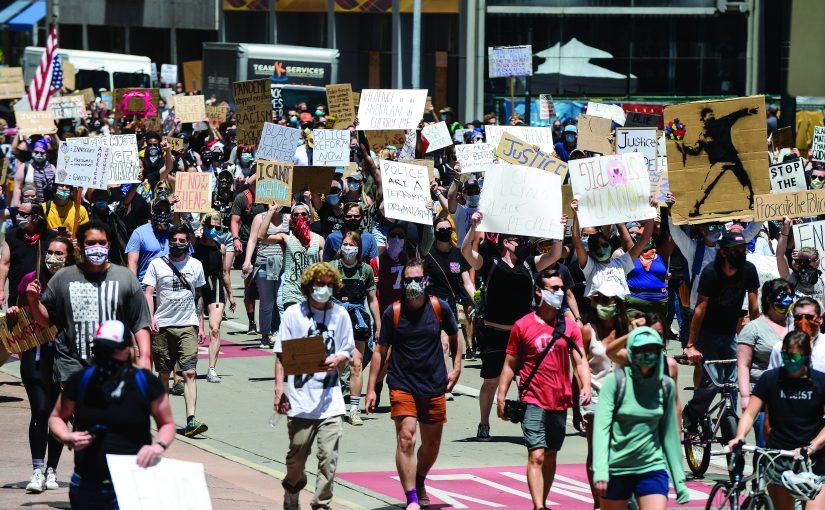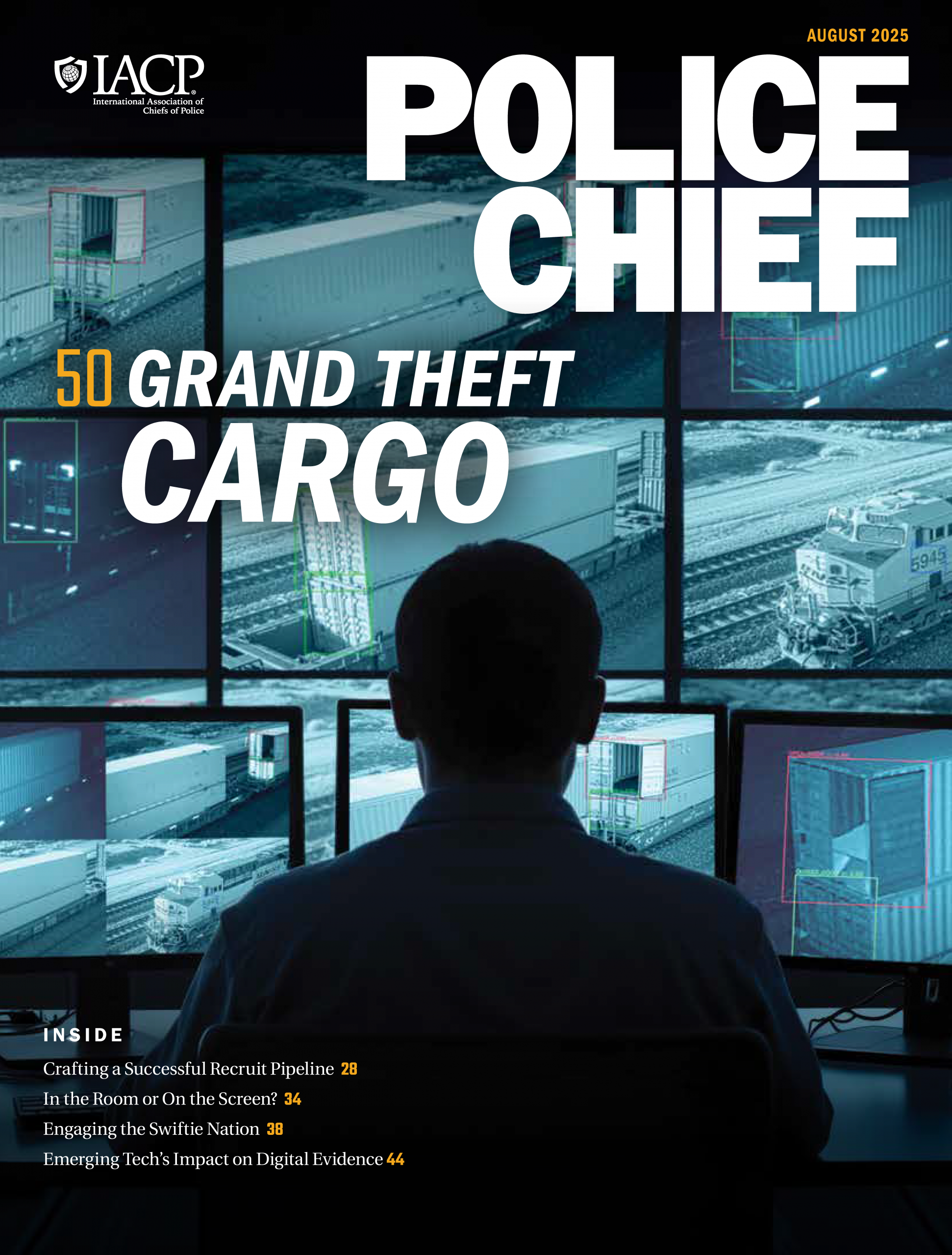Across the world, 2020 threw challenge after challenge at police. The headline may have been Covid-19, but the subheadings have been many.1 From the unprecedented need to enforce a public health lockdown and the resulting social ferment about connected issues of inequality, distrust in authority, and injustice to the inevitable adaptation of criminal enterprises, the palpable pendulum shift of public opinion toward police from hero to villain, and serious discussions in the United States and elsewhere about whether taxpayers should fund policing at all, policing has seen many challenges.
Through all this adversity, millions of police personnel have gotten up each day, dressed in often-inadequate personal protective equipment, left their worried families, and continued to serve their communities. Facing an unrelenting barrage of murky information and wicked problems, officers have used their ingenuity, experience, and tenacity to press ahead. It is timely to reflect on the last 12+ months, about the multiple crises that policing has faced, the profession’s responses, and what leaders might choose to do differently instead.
2020: A Masterclass in Complexity
The events of 2020 have been a masterclass in complexity. A global pandemic handled with variable success; latent inequality-fueled social discontent underscored by a poverty–Covid-19 connection; political divisions intensified by a U.S. election watched the world over; emergent economic challenges accelerated by shifts in consumer patterns, themselves resulting from lifestyle changes forced by Covid-19; unimaginable technological advancements; shifting geopolitical allegiances as nations continue to look, and think, inward, reinforced by reduced global travel; social media–invigorated conspiracy theories in all areas of life, propagated by the most powerful; and a backdrop of climate volatility resulting in extreme weather and unprecedented wildfires, placing a huge burden on many emergency services and serving as an apocalyptic backdrop to all of the above. Throw onto this bonfire 8 minutes and 46 seconds of mobile phone footage from Minneapolis, Minnesota, beamed instantaneously around the world, and the release of pent-up frustration, the multiethnic and multigenerational protests against injustice, and the calls to break apart the system are understandable, if not predictable.
While the lived experience of 2020 was one of unexpected twists and turns, there are elements that were more predictable. A global disease pandemic had been widely expected for some time, and most nations have long had pandemic plans detailing how they would respond to such a threat as part of the International Health Regulations.2 Interestingly, the United States was assessed as the best such prepared nation according to the Global Health Security Index.3 Yet, there is a significant gap between planning and reality. Well-written plans intersect with other factors including the attitudes of the public toward masks, competing political and economic considerations, broader macro trends, national identity, and myriad other variables. These interactions are complex, leading to unpredictable and unexpected outcomes.4
Similarly, the Black Lives Matter (BLM) protests were not a surprise. The BLM movement has been around since 2013, where it started as a social media hashtag (#blacklivesmatter) in response to the acquittal of George Zimmerman for killing Trayvon Martin. Since then, BLM has grown into a global movement, facilitating “local power to intervene in violence inflicted on black communities by the state and vigilantes.” BLM builds on a long tradition of black civil rights activism in the United States and advocates nonviolent protest to “end white supremacy.”5 Its prime focus has been police brutality, although the movement’s objectives are deeper, acknowledging such acts as a symptom of a wider system designed to ensure subjugation of blacks.6 That the footage of the death of George Floyd led to BLM protests is not a surprise. The intersection of this event with latent disaffection and anger, driven by and driving the aforementioned challenges of 2020, and the resulting scale, reach, and impact of the protests were less predictable.

This unpredictability is due to complexity—more specifically, complex adaptive systems.7 Complex adaptive systems can be defined as large networks of components with no central control and simple rules of operating. They give rise to complex collective behavior, sophisticated information processing, and adaptation via learning or evolution.8 Complex adaptive systems are both difficult to fully comprehend (complex) and changing all the time in response to stimulus somewhere in the system (adaptive). They have no leader, and the constituent components influence and are influenced by each other. As such, the usual rules of cause and effect are masked, amplified, and mitigated by stimuli across multiple variables. Abrupt changes are possible and new relationships between variables emerge. Agents (participants in the network) act and react to the inputs from other agents, shifting the network as a whole.9 As there is no predetermined order in the system, the future is emergent and unpredictable.
For organizations and their leaders, this means that the years of police experience can be a hindrance rather than an asset. When faced with a feeling of unfamiliarity and uncertainty, it can be tempting to hold onto a bedrock of experience.10 Yet, complexity theory teaches that relying on technical expertise, experience, or so-called best practice is of limited use. These things rest on assumptions that the future is much like the past; that the simple solution to the clearly defined problem is already known. Such assumptions are not valid in complex adaptive systems; thus, the policing profession needs to posture itself differently to respond. To succeed, police organizations and leaders are required to embrace uncertainty and explore the system through experimentation, agility, reflexive learning, and failure.
Policing and Complexity
Most police officers intuitively recognize complexity. For instance, officers know when they attend a domestic violence incident that it is never as simple as the abused partner leaving. There are complex interactions—interpersonal and systemic—that influence choices and outcomes. The police-citizen encounter influences perceptions and behaviors on both sides beyond the immediate interaction. Police also intuitively recognize the limits of their ability to effect systems change. Officers patrolling neighborhoods riddled with drug and gun crime and poverty, failing schools, and unemployment know that it is never as simple as arresting all the “bad guys.” Untangling these complex social problems is the life’s work of many frontline officers, who are problem solvers by default. Community policing inherently understands this—it chips away at a dynamic system, recognizing that police are not the entire solution, but they might shift the components in a way that gives rise to other opportunities.
At least, this might be the way police officers view their role if the organizational system that sits behind them recognized crime problems as emergent, interconnected, and dynamic, and set policing up to deal with complexity, rather than viewing events as a series of static linear challenges to be knocked off one by one. The authors suggest that police organizations are very well prepared to execute the latter. The police organize ourselves in hierarchical, command, and control-focused, experience-privileging bureaucracies. Everyone knows what to do. The officers train, plan, and prepare. And when trouble looms, their can-do culture and shared identity leads them to go the extra mile, typically to get the win. However, many police feel frustrated by their limited impact on the larger root problems. In response, and in their archetypal ingenious way, many have come up with well-intended, albeit police-led, interventions that reach upstream. Police officers “get” complexity. But the tools they have at their disposal are limited.11 The past year has shown that police (and many other fields) should draw on a knowledge of complex adaptive systems and explore ways in which they might do things differently.
Organizing for Complexity
Complex adaptive systems are not closed, controllable, or predictable, and dealing with them requires a level of intellectual, tactical, and organizational agility that is antithetical to the way police bureaucracies are set up. Police organizations (in fact, most organizations) rest on the sort of hypothetical-deductive reasoning that says that understanding the parts allows one to make safe inferences about the whole.12 There is a leader, and he or she is in charge. This provides a comfortable line of accountability. Police organizations are static, structured, and predictable (at least in theory), which can be a source of comfort for both community members and staff. And, in times of uncertainty, there is a temptation to hold even tighter to the structures in place. However, complex adaptive systems require something different. They invite actors to embrace uncertainty, to experiment and learn, and to be agile and willing to modify their approaches should the circumstances change, the system shift, and something else be required instead. According to emergency medicine Drs. David Petrie and Robert Swanson, “If we insist on applying machine models to complex system problems, we are doomed to fail.”13 Police officer discretion enables practical agility to a degree, but as a profession, policing balks at letting go of the way things have always been done. Policing allows for experimentation, but it is risk-averse and structed for following commands, which is not helpful in a complex adaptive world.
“To be successful at this, police need to hold their power and authority lightly.”
So how can policing better posture for a complex adaptive future? At one end of the spectrum there is much to reflect on in current arguments to defund the police. If one can move past the visceral reaction such entreaties evoke in those passionate about the profession, there might be merit in exploring the value of jettisoning 100+ years of tradition, process, and experience and starting all over again, rethinking the entire concept of public safety, creating a free-flowing matrix involving community stakeholders and others to keep community members safe.14 That would certainly be agile. At the other end of the spectrum, the field could simply regard the challenges of 2020 as a blip on the timeline of successful policing, hold on to the status quo, and hope that normal, predictable service will be resumed as soon as [insert scapegoat of choice] is dealt with. That would certainly be naïve. Somewhere in the middle is an understanding that Covid-19 has offered police and society an opportunity to learn how policing needs to evolve. Complex problems are here to stay, and policing has a stake in that game whether it wants one or not. To advance a conversation about what might serve policing well in the coming years, the authors propose three strategic organizational investments. These investments require leadership, but they are not just about leaders. They are about building the organizational capabilities needed to thrive in complexity. Policing must invest in these three strategies:
1. Systems activism
2. Diversity of thought
3. Social capital
Systems Activism
Once social problems are viewed as emergent from a complex adaptive system, it is possible to rethink policing’s sphere of influence and recognize the benefit of being a conscious system actor. Once policing is seen as having a role as a system actor, the profession can consider different ways to engage and use influence, rather than authority, to activate others into action.15 At first blush, this suggestion stands in stark contrast to current defund-the-police narratives calling for radical shrinkage and the “de-policification” of social problems.16 While there is inherent value in the criminal justice system’s occupying a smaller role in society, it is possible for policing to be expansive without expanding the police. Police are part of a multifaceted tapestry of social stakeholders. Police have an interest in preventing problems descending into crimes, and police often have a better sense of failing upstream systems by virtue of their engagement with those who fall through the cracks. If police can resist the urge to “own” non-crime problems, and as such, afflict interventions with a distinctly “police-y” feel, their perspectives can add value, and they can contribute meaningfully to disrupting the system. It may be impossible to predict the consequences of such disruption, of course, but experimentation, reflection, and reorientation are important skills in systems activism.
 To be successful at this, police need to hold their power and authority lightly. They must empower others and influence those beyond their typical boundaries.17 They must take a bird’s eye view of the system and consider avenues for intervention that do not give primacy to police, and they must have agility enough to slip in and out of role, recognizing those situations in which they must step into their police orientation and those where they can better influence and activate others. This is the essence of shared leadership inside organizations.18 Being a systems activist, rather than systems backstop, enables policing to be more effective in a supporting, nudging, and influencing role.
To be successful at this, police need to hold their power and authority lightly. They must empower others and influence those beyond their typical boundaries.17 They must take a bird’s eye view of the system and consider avenues for intervention that do not give primacy to police, and they must have agility enough to slip in and out of role, recognizing those situations in which they must step into their police orientation and those where they can better influence and activate others. This is the essence of shared leadership inside organizations.18 Being a systems activist, rather than systems backstop, enables policing to be more effective in a supporting, nudging, and influencing role.
Diversity of Thought
Being able to see the system rests on an ability to see a set of circumstances from multiple perspectives. There are many leaders who embody this well and can assume the perspective of other stakeholders and recognize areas of organizational overlap and contention around which systems work needs to occur. For most people, however, viewing a problem from multiple perspectives is best assisted by engaging with multiple people and, more important, multiple perspectives. Despite best efforts to the contrary, diversity of thought is not naturally occurring in police organizations. Even if an agency is fortunate enough to recruit and retain a workforce drawn from varying backgrounds, the shared experience of the academy and formative pathway through the front line ensures that, whatever officers’ ethnicity, gender, class, or life experiences, they invariably identify as “blue.”19
 If the police are to view the system and engage with diversity of thought, then they need to get better at valuing diversity of thought—including that expressed through courteous insubordination—within the ranks.20 Diversity of thought supports and is mutually dependent on a culture of learning that pre-supposes the organizational agility, flexibility, and adaptability that scholars agree are necessary to deal with complexity and to develop more innovative solutions to complex problems.21 Creating the enabling environment for this within organizations is a role for police leaders. Psychological safety, respect, voice, and fairness are all important ingredients.22 These factors hold true for police engagements outside the organization too, indicating how leaders may build the uneasy alliances necessary to tap into true diversity of thought.
If the police are to view the system and engage with diversity of thought, then they need to get better at valuing diversity of thought—including that expressed through courteous insubordination—within the ranks.20 Diversity of thought supports and is mutually dependent on a culture of learning that pre-supposes the organizational agility, flexibility, and adaptability that scholars agree are necessary to deal with complexity and to develop more innovative solutions to complex problems.21 Creating the enabling environment for this within organizations is a role for police leaders. Psychological safety, respect, voice, and fairness are all important ingredients.22 These factors hold true for police engagements outside the organization too, indicating how leaders may build the uneasy alliances necessary to tap into true diversity of thought.
Social Capital
The preceding two sections necessitate engaging with other stakeholders. Doing so effectively requires a conscious investment in social capital. Social capital describes what develops when individuals invest in social relationships in ways they think will bring advantage in the future.23 Social capital holds systems together in ways that are not immediately obvious. It is how interjurisdictional cooperation is smoothed and how intelligence is shared between individuals. Building social capital between fellow police comes easily—it is facilitated by shared experiences and is embedded in the common reference to a “police family.” This presents challenges too, though, as the tight bond among police suggests a preference of officers to work with like people. Engaging with dissimilar people from groups outside policing, with whom there is little shared experience and trust, is not easy. Good emotional intelligence among actors can help because prosocial strategies enable more effective engagement.24 In addition, creating shared spaces, including learning spaces, for actors to incidentally engage with each other also helps. It is no mistake that police and military have long used multi-agency training opportunities to generate operationally useful networks. Shared leadership development opportunities can be particularly useful because they invariably focus on reflection and self-understanding, and in doing so, create an environment in which trusting networks can develop. Social capital not yet earned cannot be spent, and building social capital requires conscious effort, time, and dedication. It cannot be left until a crisis occurs.
Preparing for Protracted Crises

One final thought bears consideration. Unlike most crises police organizations prepare for, including those that are complex, Covid-19 presents additional challenges because of its protracted nature. Police departments have struggled to maintain an emergency footing; the public have fatigued and become less tolerant of lockdowns and associated enforcement measures; and concern about the attendant damage that Covid-19 has wreaked on the economy, educational prospects, and mental and physical health has grown. There is some value to be had, in terms of better understanding of the choices within the systems in play, by reframing the policing experience of 2020 as a protracted crisis. Doing so helps incorporate learnings from other protracted crises, including the management of long-term humanitarian crises in low-income countries in which responses are phased and change over time. Early in a humanitarian crisis, the need for emergency relief is characterized by the fast distribution of resources. As time goes by, a longer-term phase focuses on strategies to encourage sustainable development.25 This model underscores an evolving relationship between responder and recipient, stressing the importance of partnership. The same logic could be applied to policing Covid-19 in 2020: the initial focus on managing lockdowns, drawing on engage, explain, and enforcement approaches, gives way to a longer-term strategy of developing (reinforcing or rebuilding) relationships with communities based upon mutual support and trust to co-create sustainable solutions. It is interesting that this model of dealing with protracted crises is in stark contrast to the debates emerging around the world, where corona-fatigue is being met with threats of harsher penalties, higher rates of enforcement, and further disenfranchisement of the very communities whose cooperation is required for policing to function in this and future crises. Complexity should be considered hand-in-hand with the nature of protracted crises. There is much to learn on both fronts—and much to risk if those lessons are overlooked or ignored.
Conclusion
The experiences and complexity of policing in 2020 are emblematic of a complex adaptive system, and within such systems tried and tested responses are ultimately flawed. However, the authors argue that the police role in the system could usefully shift, with responses better rooted in agility, experimentation, and engagement. Achieving this is no small feat. Policing organizations are not wired that way. To assist the shift, three investments have been suggested: systems activism, diversity of thoughts, and social capital. This shift offers hope to frontline officers frustrated by an inadequate toolkit and carves a role for leaders in police organizations to embrace the notion of shared leadership on behalf of their organizations. This reassessment may become increasingly important as Covid-19 enters its second and third waves in early 2021 and communities increasingly question the cost-benefits of the sanctions imposed.
Whatever the trajectory of Covid-19, the experience of 2020 should spur us toward further debate. The world will continue to be complex, and policing will be further challenged. Climate change represents a growing threat with attendant crises of drought; famine; people movement; water, food, and environmental crimes; and disease. Geopolitical shifts can be seismic, and the cultural givens of today may change. Without recognizing these complex systems and new ways to engage with them, policing will be ill equipped to secure meaningful public safety. Covid-19 does not provide a template for the future, but it has laid bare organizational shortfalls and given some helpful indicators about the new capabilities needed. The real question for police organizations is one of will: to accept their role in a complex adaptive system as part of a team of interconnected interdependent actors, influencing and being influenced by an ever-changing system, or continue with business as usual, hoping that their experience, grit, and tenacity will enable them to control a system that is inherently beyond anyone’s control.
Notes:
1 The official name given to the virus that causes what has become known as Covid-19 is Severe Acute Respiratory Syndrome Coronavirus 2 (SARS CoV2).
2Mark S. Smolinski, Margaret A. Hamburg, and Joshua Lederberg, Microbial Threats to Health: Emergence, Detection, and Response (Washington, DC: National Academies Press, 2003).
These plans set out rules for the development and stockpiling of vaccines (where one exists), personal protective equipment (PPE), and other medical supplies; how hospitals will be used; contingency plans should hospitals become overwhelmed; and the roles and responsibilities of various actors relevant to the public health response. World Health Organization, International Health Regulations, 3rd ed. (2005).
3Elizabeth E. Cameron, Jennifer B. Nuzzo, and Jessica A. Bell, GHS Index: Building Collective Action and Accountability (Nuclear Threat Initiative, 2019).
4The unexpected factors, in part, explains how the United States’ primacy in pandemic planning has not been mirrored by success in execution. The United States has the dubious distinction of having one of the highest Covid-19 infection and death rates in the world.
5Black Lives Matter, “Herstory.”
6OxfordUnion, “Black Lives Matter: Full Panel Discussion,” YouTube video, 1:21:40, January 4, 2017; Daina Ramey Berry, “American Slavery: Separating Fact from Myth,” The Conversation, June 19, 2017; 13th, directed by Ava DuVernay (Kandoo Films, 2016).
7Scott Page, Diversity and Complexity, Primes in Complex Systems, vol. 2 (Princeton, NJ: Princeton University Press, 2011).
8Melanie Mitchell, Complexity: A Guided Tour (Oxford, NY: Oxford University Press, 2009).
9Evidence Scan: Complex Adaptive Systems (The Health Foundation, 2010).
10Victoria Herrington and Andrew Colvin, “Police Leadership for Complex Times,” Policing 10, no. 1 (March 2016): 7–16.
11Victoria Herrington, “The Success of Failure: Can We Really Build Learning Organizations in Policing?” (presentation, 45th James Smart Memorial Lecture, Edinburgh, Scotland, December 14, 2017).
12David A. Petrie and Robert Chad Swanson, “The Mental Demands of Leadership in Complex Adaptive Systems,” Healthcare Management Forum 31, no. 5 (September 2018): 206–213.
13Petrie and Swanson, “The Mental Demands of Leadership in Complex Adaptive Systems.”
14Such a position set out in a 2020 op-ed piece in the New York Times on by Mariame Kaba who noted that previous efforts to reform the police—including a Presidential Taskforce on 21st Century Policing set up by President Obama in the wake of the death of Trayvon Martin—had not worked. Kaba stated the only means to limit police brutality was to limit all contacts between the police and the public, necessitating the police’s abolition. Mariame Kaba, “Yes, We Mean Literally Abolish the Police,” New York Times, June 12, 2020.
15Steve Waddell, “Four Strategies for Large Systems Change,” Stanford Social Innovation Review (Spring 2018).
16Andrew Miller, “The Policing Task and the Expansion (and Contraction) of British Policing,” Criminology & Criminal Justice 13, no. 2 (April 2013): 143–160.
17Chris Ernst and Donna Chrobot-Mason, “Flat World, Hard Boundaries – How To Lead Across Them,” MIT Sloan Management Review 52, no. 3 (Spring 2011): 81–88; Valeria Guarneros-Meza and Steve Martin, “Boundary Spanning in Local Public Service Partnerships: Coaches, Advocates or Enforcers?” Public Management Review 18, no. 2 (2016): 238–257.
18Edward A. Flynn and Victoria Herrington, Toward a Profession of Police Leadership, New Perspectives in Policing (Harvard University & National Institute of Justice, 2015).
19Abby McLeod and Victoria Herrington, “Valuing Different Shades of Blue: From Diversity to Inclusion and the Challenge of Harnessing Difference,” International Journal of Emergency Services 6, no. 3 (November 2017): 177–187.
20McLeod and Herrington, “Valuing Different Shades of Blue.”
21Carmen M. Felipe, José L. Roldán, and Antonio L. Leal-Rodriguez, “An Explanatory and Predictive Model for Organizational Agility,” Journal of Business Research 69, no. 10 (October 2016): 4624–4631; Angelos Pantouvakis and Nancy Bouranta, “Agility, Organisational Learning Culture and Relationship Quality in the Port Sector,” Total Quality Management and Business Excellence 28, no. 3-4 (online September 2015): 366–378; Page, Diversity and Complexity.
22Mike Hough, Good Policing: Trust, Legitimacy and Authority (Bristol, UK: Bristol University Press, 2021).
23Ronald S. Burt, “Structural Holes versus Network Closure as Social Capital,” in Social Capital: Theory and Research, eds. Nan Lin, Karen S. Cook, and Ronald S. Burt (New York: Taylor & Francis, 2001): 31–56; Nan Lin, “Building a Network Theory of Social Capital,” Connections 22, no. 1 (1999): 28–51.
24Chris Ernst and Chrobot-Mason, “Flat World, Hard Boundaries.”
25Maria Kett, “Displaced Populations and Long Term Humanitarian Assistance,“ BMJ 331, no. 7508 (July 2005): 98–100.
Please cite as
Victoria Herrington and Karl A. Roberts, “Policing in Complexity: Leadership Lessons from an Annus Horribilis,” Police Chief Online, February 10, 2021.



